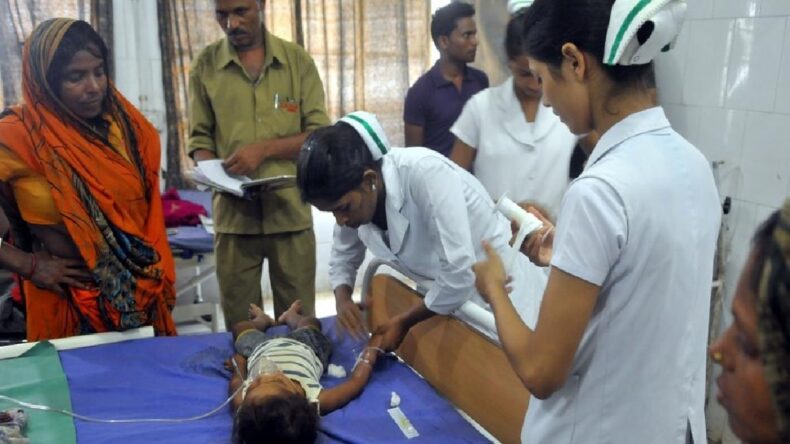In brief:
- Healthcare delivery in India has focused on investing in digital technology during and after the pandemic maximizing the clinical, financial, and operational value of these digital offerings and services.
- The market size of the Indian healthcare sector is expected to reach $372 billion with a compounded annual growth rate of around 22% with the pandemic.
- Some of the major initiatives taken by the Government of India in the Union Budget 2022-23 are the World bank approving a US$1 Billion loan towards India’s Pradhan Mantri-Ayushman Mission, funding the clinical trials of iCOVACC vaccine by Bharat Biotech, etc.
- FDI(Foreign Direct Investment) incursion for the drugs and pharmaceuticals sector between April 2000-March 2022, stood at US$ 19.41 billion, according to the data released by the Department for Promotion of Industry and Internal Trade (DPIIT).
- Medical Termination Act, Medical Device & Cosmetic Bill, and Public Health Act are among some of the important acts/bills that were proposed in 2022.
- Nationwide protests and strikes are some of the areas that are still being questioned by millions of people regarding fair pay and universal healthcare.
Healthcare has become one of the largest sectors in India, both in terms of revenue and employment. Its delivery system is categorized into two major components-public and private. The public healthcare sector comprises limited secondary and tertiary care institutions compared to the Private sectors, which provide most of the secondary, tertiary, and quaternary care institutions, especially in tier-I and II cities. Over the years the government has launched policies, initiatives, health missions, and five-year plans to deliver better healthcare to its citizens.
Leveraging digital technology
The COVID-19 pandemic has accelerated the need for digital urgency by exhibiting that healthcare organizations can become more pliable, agile, and innovative. The explosion of data generated through them can be used to build a new ecosystem that dances around the needs of an individual along with delivering trust.
Keeping up with the velocity and variety of data generated helps the providers to interconnect for highly personalized care. Several reforms like National Health Digital Mission (NDHM), teleconsulting guidelines combined with exploding health tech start-up ecosystem have evolved to make the healthcare journey better for the Indian population.
Market size
The Indian healthcare sector is expected to record growth with a compounded annual growth rate of 22% from US$ 110 billion in 2016 to US$ 372 billion in 2022.
India’s public expenditure on health published in the Economic Survey of 2022, stood at 2.1% of GDP in 2021-22 against 1.8% in 2020-21 and 1.3% in 2019-20.
It is estimated that the e-health market size can reach US$ 10.6 billion by 2025. The Indian medical tourism market which was valued at US$ 2.89 billion in 2020 is expected to reach US$ 13.42 billion by 2026.
Government Initiatives
Rs. 86,200.65 crores (US$ 11.28 billion) was allocated to the Ministry of Health and Family Welfare (MoHFW) in the Union Budget 2022-23.
In July 2022, the World Bank approved a US$ 1 billion loan for India’s Pradhan Mantri-Ayushman Bharat Health Infrastructure Mission.
In May 2022, the Union Government approved grants for five new medical colleges in Gujarat (Navsari, Porbandar, Rajpipla, Godhra, and Morbi) with a grant of Rs. 190 crores each.

Investments/ Developments
In the first six months of 2022, the healthcare and pharmaceutical sector in India had marketing & advertising worth US$ 4.32 billion. On the other hand, the FDI influx in sectors such as hospitals and diagnostic centers, and surgical appliances are predicted to grow to $372 billion by 2022.
More than 210.31 crore COVID-19 vaccine doses have been administered across the country as of August 23, 2022, whereas India has exported 24.24 crore vaccine doses.
iNCOVACC, a recombinant adenovirus vaccine with a SARS CoV-2 spike protein, is the world’s first intranasal vaccine to allow delivery of vaccine through nasal drops. These clinical trials were funded and the product development was initiated by the Government of India, Department of Biotechnology’s, COVID Suraksha Programme.
Important health acts/bills drafted this year
- The proposed National Public Health Act for a new national public health law has been in the works since 2017 and, once approved, will replace the 125-year-old Epidemic Diseases Act, of 1897. The draft Bill proposes a four-tier health administration planning, with well-defined” powers and functions at the time of public health emergencies. The proposed law also provides public health cadres at national and state levels.
- Draft of New Drugs, Medical Devices and Cosmetics Bill, 2022. The Drugs and Cosmetics Act, of 1940 is a pre-independence legislation enacted by the Central Legislative Assembly. In this draft, it has been decided to solicit suggestions/ comments/ objections from the public/ stakeholders with regard to the said draft Bill. The suggestions/ comments/ objections may now be forwarded within 45 days from the date of issue of this draft.
- Supreme Court’s judgment under the Medical Termination of Pregnancy(MTP) Act 2022, to include women, irrespective of their marital status, allowing them to terminate pregnancies up to 24 weeks advocates India’s commitment to safeguarding the constitutional right and deliver safe and legal abortion to every woman.
- Indian Public Health Standards(IPHS) guidelines 2022 are a set of standards envisioned to improve the quality of healthcare delivery across the country under the National Rural Health Mission(NRHM). At present these guidelines are applicable only for Community Health Centers (CHCs) focusing on the availability of specialist doctors in the CHCs, reinforcing support staff, and guidelines for managing routine and emergency cases under National Health Programmes are included.
- The Ministry of Health and Family Welfare(MoHFW) under the Digital Health laws and Regulation Report 2022, intended to create a judicial body in the form of a National Digital Health Authority(NDHA) to promote and adopt e-health standards, enforce privacy and security measures for e-health data, and regulating its storage and regulation through DISHA.
ROAD AHEAD 2022
India’s healthcare sector is extremely diversified and is full of opportunities for providers, payers, and medical technology. With the increase in competition, businesses are looking forward to exploring the latest architecture and trends which will have a positive impact on their business as well as focus on delivering quality health care to citizens. Besides, Indians have become more conscious of their healthcare upkeep and well-being, which leads to greater involvement of health insurance aided the rise in healthcare spending. The central government aims to develop India as a global hub for healthcare by spending 2.5% of the country’s GDP by 2025.
CHALLENGES
Apart from so many initiatives/investments from the government, there are some alarming issues being raised by millions of people regarding healthcare. Recently nearly 10 million Anganwadi, ASHA, and mid-day workers called for nationwide strikes to discuss basic health and nutrition facilities that have come to a halt impacting millions of people, especially mothers and children in rural India.
Apart from these, several protests were conducted by the frontline COVID workers who joined a platform with 10 trade unions demanding fair pay and improved working conditions. On the other hand, the new rise in COVID cases and deaths, along with the measles outbreak in Bombay and its neighboring states due to low coverage of vaccination are some of the key challenges in the healthcare sector that the government needs to address by forming a bridge among communities and providing universal healthcare.













